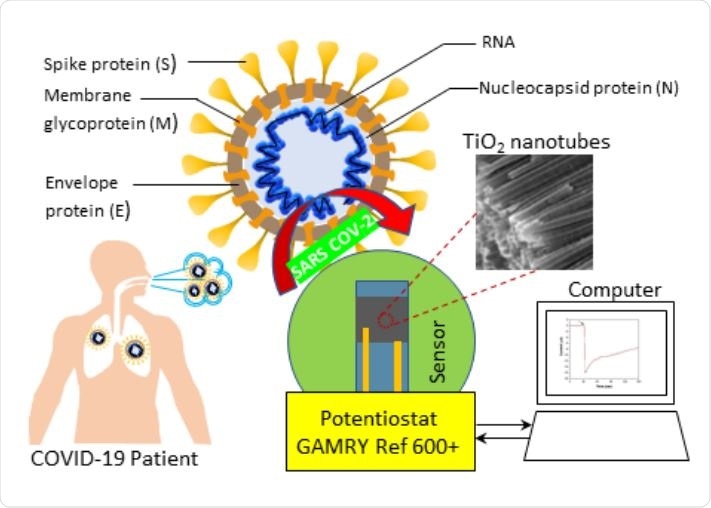The relentless pandemic of coronavirus disease (COVID-19), caused by SARS-COV-2, resulted in a disruption to society not experienced since the 1918 influenza pandemic. One of the reasons for such rapid spread of the virus is the asymptomatic clinical presentation in many infected individuals, which contributes to involuntary transmission.
Consequently, consistent surveillance and quarantining of not only infected individuals but also asymptomatic ones could provide a somewhat effective measure to curtail further spread of SARS-CoV-2.
Nonetheless, methods that are currently being used for SARS-CoV-2 diagnosis are time-consuming, expensive, and require trained personnel – albeit certain inexpensive solutions are obtaining approvals for emergency usage.

Schematic of Co functionalized TNT based sensing platform for the detection of SARS-CoV-2.

 This news article was a review of a preliminary scientific report that had not undergone peer-review at the time of publication. Since its initial publication, the scientific report has now been peer reviewed and accepted for publication in a Scientific Journal. Links to the preliminary and peer-reviewed reports are available in the Sources section at the bottom of this article. View Sources
This news article was a review of a preliminary scientific report that had not undergone peer-review at the time of publication. Since its initial publication, the scientific report has now been peer reviewed and accepted for publication in a Scientific Journal. Links to the preliminary and peer-reviewed reports are available in the Sources section at the bottom of this article. View Sources
The promise of electrochemical biosensors
Electrochemical biosensors are a favorable choice for sensing biomolecules due to their propensity to detect biomarkers with adequate accuracy, high sensitivity, and specificity. As a result, they have been used to detect influenza viruses, enteroviruses, and Middle East respiratory syndrome coronavirus (MERS-CoV).
The functionality of such electrochemical biosensors can be additionally improved by nano-structuring the electrode since this step increases the electrochemical reaction rate by increasing the electrode surface area to analyte fluid volume.
This is why researchers from the University of Nevada in Reno, hypothesized that SARS-CoV-2 could be detected through complexing of functionalized nanoparticles with characteristic viral proteins.

SEM micrographs of (a) TNTs post-annealing. Inset shows sidewalls of TNTs and (b) Co-functionalized TNTs showing the Co(OH)2 precipitate. Inset shows an EDS map of Co confirming its uniform distribution.
Synthesizing titanium dioxide nanotubes
This group of researchers, led by Dr. Bhaskar Sravan Vadlamani, developed a cobalt-metal functionalized titanium dioxide nanotubes (Co-TNT) as a sensing material for electrochemical detection of SARS-CoV-2 by detecting the receptor-binding domain (RBD) of spike glycoprotein.
More specifically, titanium dioxide nanotubes (TNTs) were synthesized by electrochemical anodization of titanium sheet. The annealed TNTs acquired from the furnace were functionalized with cobalt by employing an incipient wetting method, i.e., a wet ion exchange process.
The morphology of the TNTs and Co-TNT was then examined with the use of Dual Beam Scanning Electron Microscopy. Moreover, the spike-RBD protein, the aforementioned biomarker for SARS-CoV-2 detection, has been characterized via sodium dodecyl sulfate-polyacrylamide gel electrophoresis (SDS-PAGE) under denaturizing conditions.
The ability of Co-TNT to sense spike-RBD protein of SARS-CoV-2 was determined by carrying out an amperometry experiment at -0.8 volts. Finally, the electrochemical sensing was performed with the use of a custom-built Co-TNT packaged and printed circuit board setup.
SARS-CoV-2 concentration and detection time
The study has shown that the sensor detected the spike-RBD protein of SARS-CoV-2 even at very low concentrations (ranging from 14 nM to 1400 nM). Furthermore, a linear response in the detection of viral protein with concentration has been demonstrated.
Importantly, the time needed for detection was very short (approximately 30 seconds), confirming the possibility of using this technology to develop a rapid diagnostic assay that can be exploited as a point of care diagnostics for rapid SARS-CoV-2 detection.
Also, the average sensor response time (defined as the time needed to reach the peak current) was found to be approximately 2 seconds. This is very short in comparison with earlier studies from the same authors on the sensor for colorectal cancer, as sensor response time there was 100-fold higher.
Scalable diagnostic platform
"Our report demonstrates the development of a simple, inexpensive, rapid, and non-invasive diagnostic platform that has the potential of detecting SARS-CoV-2 on clinical specimens including nasal, nasopharyngeal swabs or saliva" study authors summarize their findings.
"Moreover, the developed approach has the potential for diagnosis of other respiratory viral diseases by identifying appropriate metallic elements to functionalize TNTs," they add in this medRxiv preprint paper.
Advantageously, the sensor readout is an electrochemical signal gathered through a potentiostat or galvanostat, which can be adopted for smartphone applications and point of care diagnostics for COVID-19.
Finally, the sensor sensitivity may also be improved by using longer Co-TNT, since higher surface area provides a better reaction rate. As a result, higher sensor response current can be reached even at lower protein concentrations. All of this makes this technology a potentially useful addition to our diagnostic armamentarium.

 This news article was a review of a preliminary scientific report that had not undergone peer-review at the time of publication. Since its initial publication, the scientific report has now been peer reviewed and accepted for publication in a Scientific Journal. Links to the preliminary and peer-reviewed reports are available in the Sources section at the bottom of this article. View Sources
This news article was a review of a preliminary scientific report that had not undergone peer-review at the time of publication. Since its initial publication, the scientific report has now been peer reviewed and accepted for publication in a Scientific Journal. Links to the preliminary and peer-reviewed reports are available in the Sources section at the bottom of this article. View Sources
Journal references:
- Preliminary scientific report.
Vadlamani, B.S., Uppal, T., Verma, S.C. & Misra, M. (2020). Functionalized TiO2 nanotube-based Electrochemical Biosensor for Rapid Detection of SARS-CoV-2. medRxiv. https://doi.org/10.1101/2020.09.07.20190173.
- Peer reviewed and published scientific report.
Vadlamani, Bhaskar S., Timsy Uppal, Subhash C. Verma, and Mano Misra. 2020. “Functionalized TiO2 Nanotube-Based Electrochemical Biosensor for Rapid Detection of SARS-CoV-2.” Sensors 20 (20): 5871. https://doi.org/10.3390/s20205871. https://www.mdpi.com/1424-8220/20/20/5871.